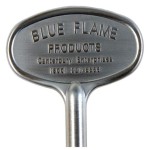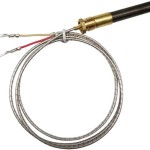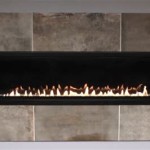Understanding the Gas Fireplace Chimney Damper
A chimney damper in a gas fireplace serves a distinct, yet crucial, function. While traditionally associated with wood-burning fireplaces, dampers in gas fireplace systems play a vital role in energy efficiency and preventing unwanted drafts. Understanding the operation and maintenance of a gas fireplace damper is essential for homeowners to ensure both comfort and cost savings.
Unlike wood-burning fireplaces, where the damper controls airflow for combustion and smoke venting, the damper in a gas fireplace often serves primarily as an energy-saving measure. Gas fireplaces produce significantly less soot and creosote than wood-burning counterparts, reducing the need for frequent chimney cleaning and eliminating the risk of chimney fires caused by creosote buildup. The primary purpose of a gas fireplace damper is to prevent heat loss when the fireplace is not in use.
Leaving a chimney damper open allows warm air from the house to escape through the chimney, a phenomenon known as the "stack effect." This effect is more pronounced during colder months when the temperature difference between inside and outside is greater. By closing the damper when the gas fireplace is not in operation, homeowners can significantly reduce heat loss and lower energy bills.
Key Point 1: The Purpose of the Damper in a Gas Fireplace
The primary function of a gas fireplace damper is to prevent heat loss when the fireplace is not in use. Although gas fireplaces don’t produce the same level of emissions as wood-burning models, the chimney still acts as a conduit for air movement. An open damper allows heated air from the home to escape, leading to increased energy consumption. Closing the damper creates a barrier, preventing the warm air from rising and exiting through the chimney.
Many older gas fireplaces might have an older style damper that is similar or identical to those used inside a wood-burning fireplace. These dampers are typically located just above the firebox and are operated by a lever or handle. Newer models may incorporate a top-sealing damper, which is situated at the top of the chimney. This design provides a more airtight seal, further reducing heat loss.
It’s important to note that some gas fireplace installations might not include a damper at all. This could be due to local building codes or the specific design of the fireplace unit. In such cases, the focus shifts to other methods of insulation and draft prevention.
Key Point 2: Identifying Damper Types and Operation
Gas fireplace dampers come in various types, each with its operating mechanism. The most common types include throat dampers and top-sealing dampers. Throat dampers are situated just above the firebox, operated by a lever or handle. These can be prone to rust and sticking over time.
Top-sealing dampers, located at the top of the chimney, offer a more airtight seal and are generally more energy-efficient. They are often operated by a chain or cable that extends down into the firebox. These dampers are advantageous because they seal the entire chimney opening, not just the area immediately above the firebox. This helps prevent drafts and keeps out rain and debris.
To determine the type of damper in your gas fireplace, visually inspect the chimney opening. If you see a metal plate with a lever or handle near the firebox, it is likely a throat damper. If you see a chain or cable extending from the top of the chimney to the firebox, it is likely a top-sealing damper. Understanding the type of damper you have is crucial for proper operation and maintenance.
Key Point 3: Maintenance and Troubleshooting of Gas Fireplace Dampers
Regular maintenance is crucial to ensure the proper functioning of a gas fireplace damper. Over time, dampers can become stuck, rusted, or damaged, hindering their ability to seal effectively. This could result in energy inefficiency and increased heating costs.
To maintain a throat damper, periodically inspect it for rust, debris, and obstructions. If the damper is difficult to open or close, apply a penetrating lubricant to the hinges and moving parts. Ensure that the damper plate seals tightly against the chimney walls when closed. If the damper is severely rusted or damaged, it may need to be replaced by a qualified technician.
For top-sealing dampers, inspect the cable or chain for fraying or damage. Make sure the seal is clean and free of debris. If the damper is not sealing properly, adjust the cable tension according to the manufacturer's instructions. In some cases, the seal itself may need replacement if it is worn or damaged. Due to the location of top-sealing dampers, professional assistance is often recommended for maintenance and repair.
If you suspect that your gas fireplace damper is malfunctioning, it's essential to address the issue promptly. A faulty damper can lead to significant heat loss, increased energy bills, and potential safety concerns. Consult with a qualified HVAC technician or fireplace specialist for diagnosis and repair. They can assess the condition of the damper, identify any underlying problems, and recommend the appropriate course of action.
In summary, the gas fireplace chimney damper, although often overlooked, plays a significant role in maintaining energy efficiency. By understanding its purpose, operation, and maintenance requirements, homeowners can ensure optimal performance of their gas fireplace and minimize energy waste.

What Is A Chimney Damper Full Service

How To Open A Chimney Damper Traditional Fireplace Pros

Top Mount Vs Throat Dampers Fireplace Damper Portland Oregon

How Do Fireplace Dampers Work Zoro Com

Types Of Diffe Chimney Dampers Severna Park Pasadena Md

Nicholas Chimney Sweeping Stove Fireplace Services Vienna Virginia

What S The Purpose Of A Chimney Damper Where Is It Located

Top Sealing Damper Chimney Advantages

Fireplace Damper Repair Full Service Chimney Kansas City

Everything You Need To Know About Chimney Dampers All Pro Service
Related Posts








